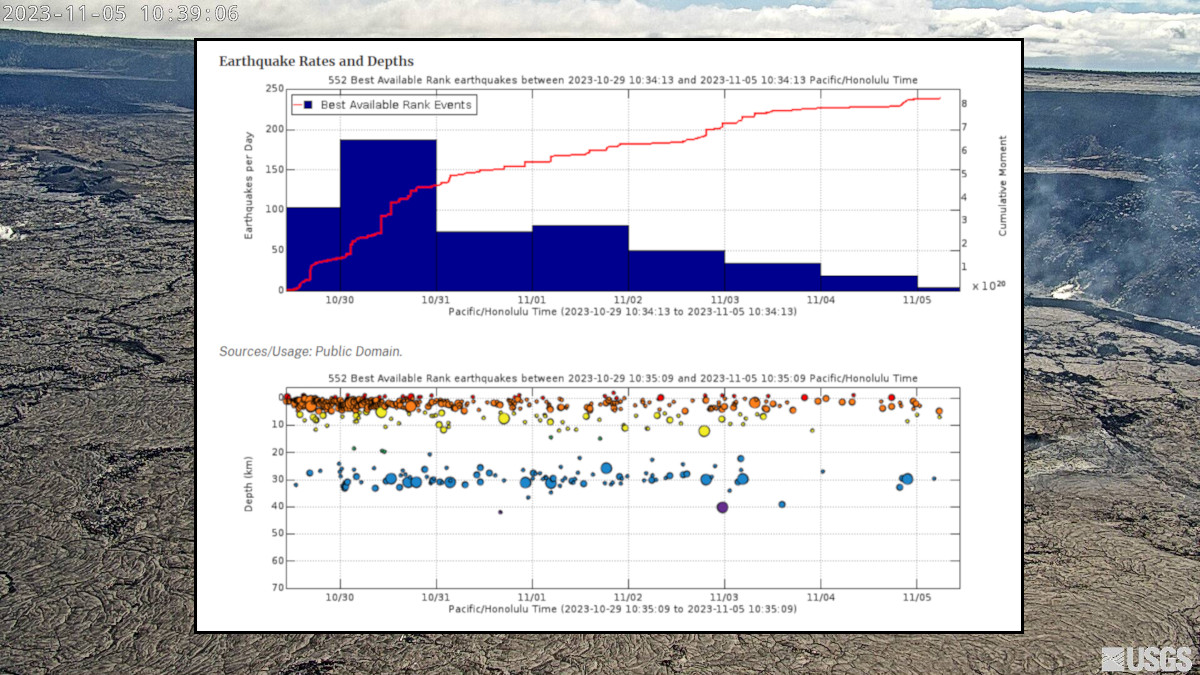This story appears in the above BIVN Update. The video will jump to the associated story when played. (A synthesized voice was utilized in the narration for this story)
(BIVN) – Kīlauea volcano is not erupting, and remains at an alert level of ADVISORY. In recent days, the unrest in the summit area that was associated with an October intrusive event has been diminished.
From the USGS Hawaiian Volcano Observatory at 9:28 a.m. HST on Sunday:
Activity Summary: Kīlauea volcano is not erupting. The unrest at Kīlauea’s summit has diminished over the past several days, with a decrease in seismicity, in association with an intrusive event that began in early October. Unrest may continue to wax and wane with changes to the input of magma into the area. The current rate of uplift at the summit of Kīlauea has also lessened significantly over the last several of days; however, eruptive activity is still possible in the coming weeks or months. No unusual activity has been noted along Kīlauea’s East Rift Zone or the Southwest Rift Zone.
Summit Observations: Unrest around the summit area of Kīlauea diminished over the past several days with a decrease in the level of seismicity. Waxing and waning of unrest may continue.
Elevated seismicity associated with an intrusion beneath the south-southwest region of Kīlauea’s summit began in early October with the greatest number of earthquakes occurring on October 4-6, 16-18, 21-23, and 26-30. Over the past 24 hours, seismic activity decreased, with approximately 1 earthquake recorded in Kīlauea’s summit region, a slight decrease from approximately 3 over the previous 24 hours. Most of the earthquakes related to this unrest have been smaller than magnitude-2 and have occurred at depths of around 1–3 km (0.6–2 mi) below the surface.
The Uēkahuna summit tiltmeter, located northwest of the caldera remained stable and measured nearly no deformation over the last 24 hours. The Sand Hill tiltmeter, located southwest of the caldera, has measured gradual, slight deflation since October 31. Overall, the current rate of uplift (as measured by GPS and tiltmeters) at the summit of Kīlauea has diminished significantly over the last several of days.
Sulfur dioxide (SO2) emission rates remain low and were measured at a rate of about 100 tonnes per day on October 19, 2023.
It is unclear if unrest in Kīlauea’s summit region will continue, and it is not possible to say with certainty if activity will lead to an eruption; activity may remain below the ground surface. However, an eruption remains possible, most likely in Kīlauea’s summit region inside of Hawai‘i Volcanoes National Park and away from infrastructure. Similar patterns of earthquake activity and ground deformation occurred to the south of the caldera prior to the September and June 2023 eruptions in Kīlauea summit caldera (in Halemaʻumaʻu crater and on the downdropped block). Volcanic gas emissions pose the greatest hazard to areas downwind of Kīlauea’s summit.
There is currently no sign of an imminent eruption and increasing inflation and earthquake activity (heightened unrest) are expected to precede an eruption. During periods of heightened unrest prior to recent eruptions at Kīlauea summit, signs of imminent eruption did not appear until 1-2 hours before lava reached the surface. The summit of Kīlauea remains at a high level of inflation and eruptive activity is possible in the coming weeks or months. HVO scientists will continue to monitor Kīlauea volcano closely and will issue additional messages as warranted by changing activity.


by Big Island Video News10:58 am
on at
STORY SUMMARY
HAWAIʻI VOLCANOES NATIONAL PARK - There has been a recent decrease in seismicity at Kīlauea, while the rate of summit uplift has also lessened significantly.